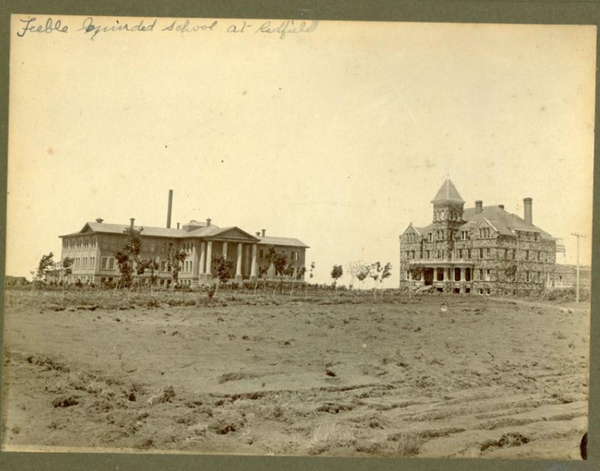Difference between revisions of "Main Page"
M-Explorer (talk | contribs) |
M-Explorer (talk | contribs) |
||
| Line 1: | Line 1: | ||
__NOTITLE__ | __NOTITLE__ | ||
| + | {| id="mp-topbanner" style="width:100%; background:#CCCCFF; margin-top:1.2em; border:2px solid #ccc;" | ||
| + | | style="width:56%; color:#000;" | | ||
| + | {| style="width:280px; border:none; background:none;" | ||
| + | | style="width:280px; text-align:center; white-space:nowrap; color:#000;" | | ||
| + | <div style="font-size:162%; border:none; margin:0; padding:.1em; color:#000;">Welcome to Asylum Projects,</div> | ||
| + | <div style="top:+0.2em; font-size:95%;">A historic asylum wiki anyone can edit.</div> | ||
| + | <div style="width:100%; text-align:center; font-size:85%;">[[Special:Statistics|{{NUMBEROFARTICLES}}]] articles and counting</div> | ||
| + | |} | ||
| + | <!-- PORTAL LIST ON RIGHT-HAND SIDE --> | ||
| + | | style="width:11%; text-align:center; white-space:nowrap; color:#000;" | | ||
| + | <div style="font-size:250%; border:none; margin:0; padding:.1em; color:#000;">We need your help!</div> | ||
| + | <div style="font-size:100%; border:none; margin:0; padding:.1em; color:#000;">[[AsylumProjects:To do list|Click here to find out how.]]</div> | ||
| + | |}<br/> | ||
{{Portal:Mission Statement}} | {{Portal:Mission Statement}} | ||
{| cellspacing="2" cellpadding="2" | {| cellspacing="2" cellpadding="2" | ||
| Line 10: | Line 23: | ||
|- | |- | ||
|} | |} | ||
| − | |||
Revision as of 13:51, 24 November 2009
__NOTITLE__
|
We need your help!
|
Mission Statement
The Mission
The mission of this site is to archive both historical and current information on asylums across the United States and around the world.
The Statement
This site is dedicated to the history of asylums in all forms. The term of asylum is applied to not only what is commonly thought of: mental hospitals, but can also be applied to sanatoriums, state training schools, reform schools, almshouses, and orphanages. These institutions have and continue to play a major part in today's society.
Everyone throughout the United States and in many other countries has in one way or another felt the touch of these institutions. These places have both directly and indirectly affected people and their families. They have shaped lives and created many popular myths about them.
With all that in mind, this site was created to help in the historical research of any institutions that can be classified as an asylum. It was created for both serious researchers, those who are doing genealogical research, and people with an interest in asylums.
Featured Article Of The WeekBattle Mountain SanitariumBattle Mountain Sanitarium (now part of the Veterans Affairs Black Hills Health Care System) was part of the National Home for Disabled Volunteer Soldiers, which provided care for Union veterans after the Civil War. It was the first and only National Home for Disabled Volunteer Soldiers built solely as a short-term sanitarium for veterans with lung or respiratory problems, not as a long-term home. Unlike the other National Home branches, veterans went to Battle Mountain Sanitarium for brief intensive treatment. Upon completion of their treatment, they were transferred to another National Home branch. Battle Mountain Sanitarium opened in 1907, offering veterans a complete array of services including plunge baths and an amusement hall. Located in the town of Hot Springs, South Dakota, the Sanitarium, made from local pink sandstone, rises above the town on a bluff to the northeast of the resort section of the town at an elevation of 3400 feet. A majority of the buildings predate 1930, and many of them are still used for their original purposes. The curving road system that winds through the facility is also original. The National Cemetery is located in the eastern section of the campus. Founded in the 1880s as a warm water mineral springs health resort, the town of Hot Springs became a popular destination for regional health seekers by 1900. Tourists enjoyed the benefits of the waters and the mountain scenery. The local effort to build a National Home branch began in the 1890s. The possibility became likely after an inspector for the National Home for Disabled Volunteer Soldiers inspected a State Soldier’s Home in the area and stated that he was impressed with the therapeutic qualities of the water. After this, 30 veterans from the Western Branch went to the State facility, and the treatments improved their health. In 1898, the Grand Army of the Republic formed a committee to convince Congress to locate a National Home branch in Hot Springs. In 1902, Congress passed legislation authorizing the new facility; the bill allocated $150,000 for the construction of buildings and $20,000 for equipment. Battle Mountain Sanitarium opened in 1907 for its first patient, Charles Wilbert, from the Marion Branch. Click here for more... Featured Image Of The WeekThe South Dakota Developmental Center was established by the state legislature in 1899. The facility opened in February 1902 as the Northern Hospital for the Insane with 45 people in a three story building made of Sioux Falls granite. All direct contact staff as well as administrative staff lived there. All legislation concerning establishment, admissions, and support indicates that these facilities were not intended to be used by people who had mental illness, but for those persons who had a developmental disability. In 1913, the name was changed to State School and Home for the Feeble Minded. It became known as The Redfield State Hospital and School in 1951 and in 1989 we took our current name.
|
Asylum News (news you can edit!)February 7, 2016 Clarinda struggles to fill former hospital
February 1, 2016 Efforts continue to preserve other parts of former Peoria State Hospital grounds
January 7, 2016 That Time The United States Sterilized 60,000 Of Its Citizens
January, 6, 2016 Pa. hires firm to develop plan for Harrisburg State Hospital site
|


